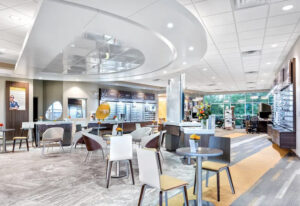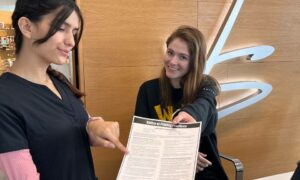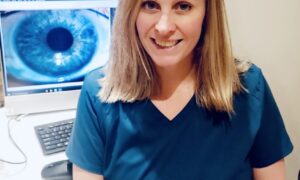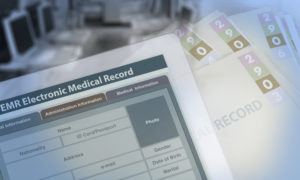
Dr. Steele’s office. He says that his practice had a modest start, but has grown substantially in recent decades.
By Kurt T. Steele, OD
June 7, 2023
I truly feel I have arrived. Laurie Sorrenson, OD, FAAO, the new professional editor of this publication, has asked me to write an article!!! Dr. Sorrenson has been my “go to” since I first met her. Truly an optometric business icon both medically and managerially. One piece of advice just right off the top of my head…. always listen to people like Dr. Sorrenson. Then go back and implement.
First a little about myself. I practice in Newport, Tenn. Have you ever seen the show “The Moonshiners”? That is where I live. For the first corneal foreign body I removed, my reimbursement was four jars of moonshine. I am still struggling with where to categorize moonshine, pies, cakes and cookies into a spreadsheet, as being from rural Appalachia, that is sometimes my “co-pay.”
I am sitting at my office at 9 p.m. on a Saturday waiting for a patient from the ER. One of the greatest joys of private practice in a rural setting is that we are truly the primary eyecare providers here. Not one ophthalmologist in my county, except for the one who works out of my office two days a month. I have been on staff at my local hospital since 1995.
When I got here, we were a practice that generated $380,000 in revenues annually. Last year we generated $3,200,000 in revenues. It only took me 27 years. I have opened a consulting business, so I can teach others how to do it much more quickly than I did.
From a philosophical standpoint, the best advice I can give is to be nice, generous and always keep your word. Several experts would cringe at what I give away to both patients and potential partners. At the same time, we have built a huge practice and gone from a two-doctor practice to a four-doctor practice in a rural area (three of us are partners).
Other Articles to Explore
Baby Steps to Going Big
Dr. Sorrenson asked me to write on either how to attract young ODs to a rural practice or how I built an “OMG business.” The path to both is the same. The best way I know to do this is list some of our watershed moments in chronological order. Reaching these goals, in this order, allowed me to build the practice we have today:
- Get more patients.
- Be able to see more patients in a day.
- Invest in your team.
- When it is time to expand or grow, do it. We have built two new buildings inside of 15 years for the same single location.
- “I’m booked out several months” is not something to brag about. You are sitting on a gold mine. Hire new doctors, give them patients, grow.
Practice Pearls for Growing a $3 Million+ Practice
On my website, I have “10 practice pearls” listed. Several of them cover the “how to grow an OMG practice”:
- Most limitations are self-imposed, and usually based in fear. When you eliminate fear from the equation, it is amazing what is possible.
- You cannot improve what you don’t measure. I love my Google sheets. I am maniacal about measuring both doctors and team members, as well as office metrics. Get accurate calculations, use them to make decisions, and you will rarely go wrong.
- The most underrated metric is doctor revenue per day. I use this at the beginning of every quarter to project revenue and set the budget.
- When possible, hire out of want, not need. Easier said than done, but as we went from a staff of two to a staff of 16, I often hired people when we weren’t hiring. Talented people with magnetic personalities make you money.
- Most doctors limit themselves with staffing and space. Don’t ever slow down your schedule because your team can’t handle it. Build your team to match your efficiency. Same goes for space. If you need another doctor but don’t have the space, add the space.
- If you’re going to say you’re the best, you must look the best. If you have gone five years without adding equipment or remodeling your space, you don’t look the best.
- Take your local medical providers and their team breakfast at least once a year. Your local medical providers love having access to immediate eyecare. They hate the eyeball.
- Survey your team members on what is important to them. I did this three years ago, and the top two were paid time off (PTO) and an accountability system that was consistent and fair. We have unbelievable PTO and a system of checks and balances that is used on everyone.
- Watch where your no-shows occur and adjust your schedule. Take your least popular time of the week and make it available for emergency “I broke my glasses” exams and chronic no-shows (don’t give them slots).
- If the exam is medical, you must bill medical. If you bill vision, you are hurting your practice and your profession. This is a long story, but take my word for it.
That ER case was a “sudden onset” 45 YOWF divergence insufficiency. I think she has had it her whole life, but it decided to start bugging her now since she is in her forties. I had her sign a waiver, she just made one of my talks! I couldn’t take a co-pay on a bet, so her husband is feeding me lunch Monday.

Dr. Steele and his wife.
Kurt T. Steele, OD, is a Partner of Vision Source of Newport in Newport, Tenn. To contact him: idoc2316@gmail.com



























